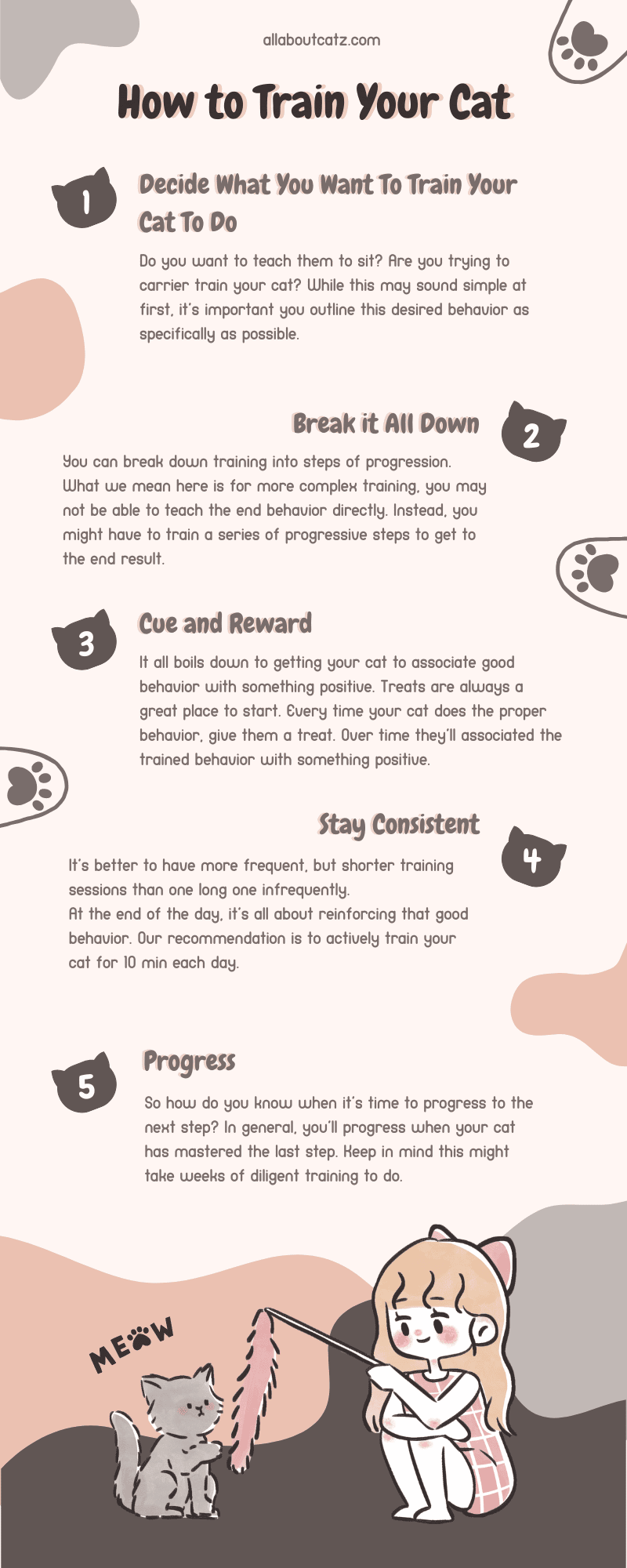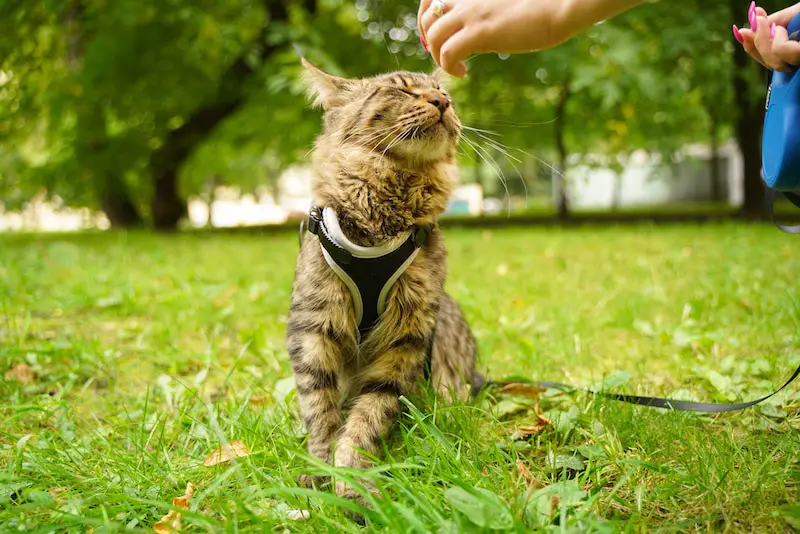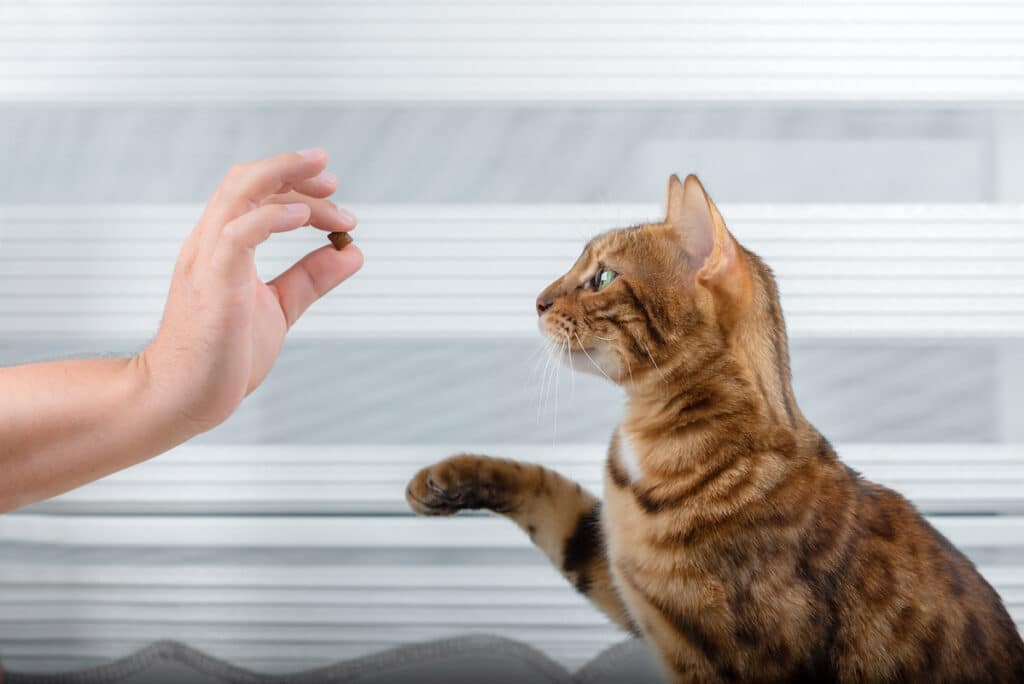Contrary to popular belief, cats can definitely be trained. We’ve compiled a step by step guide on how to train a cat that will make it easier than ever.
Table of Contents
- How to Train a Cat
- How Long Will It Take To Train My Cat?
- Punishment Training on a Cat
- What You Can Train Your Cat to Do
- Types of Rewards
- Preparation for Training a Cat
- Can Cats Be Trained?
How to Train a Cat
We’re just going to dive right into cat training 101. These steps on how to train a cat can be reused for anything you want to train your cat to do. While the desired actions may vary, the basic steps will remain the same.

Step 1: Decide What You Want To Train Your Cat To Do
The first step in the training cycle for a cat is to determine exactly what you want to train your cat to do. For example, do you want to teach them to sit? Are you trying to carrier train your cat?
While this may sound simple at first, it’s important you outline this desired behavior as specifically as possible. For instance, what do consider successful behavior when you mean “carrier train a cat”? Does it mean they don’t yowl when you close the crate door? Or does it mean you can actually get them in the carrier at all?
Knowing the desired end point is necessary in order to figure out how to get there. Write it down so you don’t forget it. Some will be simple, like getting a cat to sit on command. Others might need to be defined more specifically.
Step 2: Break it All Down
Once you’ve figured out exactly what you want to train your cat to do, you can break it down into steps of progression. What we mean here is for more complex training, you may not be able to teach the end behavior directly. Instead, you might have to train a series of progressive steps to get to the end result.
Let’s use the carrier training as an example again. The first step will be to just get them comfortable around the carrier. Then, train your cat to be comfortable laying in the crate with the door open. Next, get your cat comfortable laying in the crate with the door closed. You get the idea. Each step will be a while training cycle in itself.
At first this is hard to do, but overtime you’ll get the hang of it. Write down all the training progressions you’ll need to train your cat before getting to the final goal.
Step 3: Cue and Reward
At the heart of all cat training are the cues and the rewards. It all boils down to getting your cat to associate good behavior with something positive.
Not all training will involve cues. Most commonly a cue is a commend like “sit” or “come”. Sometimes a cue can be a hand gesture. Training your cat to not go on counters or scratch furniture are examples of training that won’t involve cues.
Rewards, on the other hand, will always be involved in training. Treats are always a great place to start. Every time your cat does the proper behavior (e.g. go in the carrier), give them a treat. Over time they’ll associated going in the carrier with getting a treat (e.g. something positive).
You can use many things as rewards. Treats a great, so is kibble. Some cats respond well to catnip. Others love getting a verbal praise and some pets from their owner.
Rewards can also be more complex. For instance, your cat might have a favorite blanket. Using that blanket to encourage them to go into their cat carrier is a form of positive association.
Step 4: Stay Consistent
The other most important part of training is consistency. It’s better to have more frequent, but shorter training sessions than one long one infrequently.
At the end of the day, it’s all about reinforcing that good behavior. Our recommendation is to actively train your cat for 10 min each day.
We’ll use the carrier training as an example again. Let’s say you’re at the step where you’re trying to get your cat comfortable laying in the carrier with the door closed. Put your cat in the carrier, giving them a treat and praise, and let them stay in there for 2 min. Repeat this several times until 10 minutes has passed.
Step 5: Progress
So how do you know when it’s time to progress to the next step? In general, you’ll progress when your cat has mastered the last step. Keep in mind this might take weeks of diligent training to do.
Once again we’ll use the carrier training as an example. Let’s say you’re on the step where you get your ca comfortable just being in the carrier with the door open. Once your cat is consistently just laying in the carrier and looking very calm, you can progress to the next step of closing the door.
How Long Will It Take To Train My Cat?
So you’re probably wondering how long all of this will take. Well, it greatly depends on what you’re trying to train your cat to do.
Getting your cat to sit on command might only take a few weeks. However, carrier training your cat to be comfortable riding in a car in their carrier might take months.
Really it all depends on the stubbornness of the cat and your consistency with training.

Punishment Training on a Cat
We strongly recommend never using negatives or punishments to train a cat. The first reason is that cats really don’t respond well to punishment. They’re likely to run and hide and end the training session, making consistent training difficult.
Bluntly, you don’t want to traumatize your cat or make your cat afraid of you. That’s just stressful for the cat and damages your relationship.
Finally, research has shown that cats respond much better to positive/reward training than they do punishment training. It’s just far more effective.
Now some exceptions to this might be using a citrus spray on areas of the furniture you’re trying to discourage your cat from scratching. We don’t really consider this a punishment, per se, but a discouragement.
Punishments are more defined by your cat’s inability to avoid it. For instance, if you spray your cat with water for not sitting on command, that’s considered punishment.
What You Can Train Your Cat to Do
Now for the fun part. What are all the things you can train your cat to do? Well, the list is endless. But we’ve compiled a list here of some of the more common things people train their cat to do.
1. Gentle
Train your cat to be gentle instead of nipping or biting your hands. Say “gentle” and then give your cat a treat if they lick your hands or do nothing after.
2. Find It
Train your cat to show you where you hid the treat. You can progress this to have them point out where the treat is after rearranging some cups with one containing a hidden treat.
Start by showing your cat two open hands, one with a treat. Close them into fist and say “find it”. Every time your cat sniffs or paws at the hand with the treat, give them the reward.
3. Sit
This simple trick is a surefire crowdpleaser. Say “sit” and gently push your cat’s rear end down until they sit and then give them the treat. Over time your cat will sit on their own.
4. Come
You can train your cat to come to you. Not only is this a cute but it’s really useful if you need to clip your cat’s nails or brush them.
5. Carrier Training
Get your cat comfortable with being in their carrier and traveling in the car. Start by leaving the carrier around and let them get used to it. Progress to rewarding your cat for going in the carrier. Over time you can get your cat used to being in the carrier with the door closed and even carrying them around in the carrier.
6. Don’t Scratch The Couch
Believe it or not, you can train your cat to not scratch furniture you prefer to remain unscathed. Start by spraying the furniture with a special cat citrus spray to discourage scratching.
Meanwhile, provide a scratch post for your cat. Every time your cat uses the scratch post, give them a treat. Over time your cat will associate the scratch post as being the best place to do their scratching.

7. Don’t Go on the Counter
Remove any food or items from the counter that might entice your cat to go there. Then, select a place you do want your cat to go instead, such as a cat tree or cat bed. Leave treats or catnip in the desired area, or give them a reward every time they go there.
Over time your cat will associate their spot with rewards instead of the counter.
8. High Five
The high five trick is always a fun, easy trick to train your cat. Start by saying “high give” and grabbing your cats arm and high fiving” your hand with it close to the ground. Given them a treat.
As time passes, your cat will learn to high five your hand close to the ground on command. From there, have your cat high five you further and further up, until they can do the classic high five.
9. Target
Target is a good trick to train your cat if you want them to touch on you or something in your hand. Begin by holding up a finger close to their face. As soon as she touches it with her nose or paw, reward the good behavior.
10. Look
Similar to target, look is a command that gets your cat to focus on you. Start by holding something in your hand that is sure to get your cat’s attention. Noisy squeakers or their favorite toy are great choices. Say “look” and hold it up. When they look at the item, reward them with a treat.
As time passes, progress to get your cat to look at you without anything exciting in your hand.
11. Leash or Harness Training
Get your cat used to wearing a harness and being on a leash. This is a great way to take your cat on walks or just be able to hang out outside with them.

12. Whatever else you can think of!
The sky is the limit with what you can train your cat to do. We recommend practicing the basic training steps outlined above before coming up with any unusual or complex tricks.
At the end of the day, cats are very trainable. Brainstorm some fun or useful trained behaviors and try them out on your cat!
Types of Rewards
Different cats respond differently to certain types of rewards. There also might be other reasons you prefer one reward over another. For instance, if your cat is overweight you might want to skip the treats and instead use verbal praise. Or you can try making your own cat treats at home that are lower calorie.
1. Treats
Treats are most likely going to be the most effective type of reward for your cat. What cat can’t resist savory chicken or delectable salmon flavors?
2. Clicker
Using a clicker is one of the most common training rewards A clicker is a simple device that makes a sharp, distinguishable clicking noise when you press it. You can find clickers for sale online or at your local pet store.
The clicker noise in itself is not a reward. You first have to train your cat to associate the clicker noise with a reward. Spend a few weeks giving your cat a treat right after clicking the clicker.
With time, your cat will perceive the clicks as being very positive, and will respond to the clicker like it’s a treat. This is a great way to keep from having to constantly give your cat treats, which is not good for their health.
3. Catnip
Most cats go crazy for catnip. This reward is great for getting your cat to go or stay certain places. For instance, putting a little catnip in their carrier will entice them to go in there.
4. Praise
Depending on the cat, praise can be a useful form of reward. Verbal praise or pets can be encouraging.
5. Kibble (Dry Cat Food)
Like treats, dry cat food can be very enticing to cats. The advantage that kibble has over treats is that usually each individual piece is smaller and lower in calories. Therefore, you can use more to train your cat without making them gain weight.
6. Your Cat’s Favorite Item
Chances are, there’s one or more items your cat loves. It might be their favorite blanket they lay on all the time. Or it could be their beloved stuffed toy.
These items work great for getting your cat to go and stay in certain places. Carrier training is a great example of this.
7. Toys
Some cats, particularly playful ones, respond well to toys as rewards. Place their toys in places you’re encouraging them to go. Toys are a great distraction from places or things that unsettle them, like cat carriers.
Preparation for Training a Cat
Preparation for cat training is essential and will set you up for success. Here are some ways to get ready for effective cat training:
1. Buy or Make Rewards
Since rewards are one of the key parts of training, make sure you’re well stocked. Purchase plenty of treats or make your own at home. Buy a clicker. Get some catnip or grow your own.
2. Plan Out Your Cat Training Strategy
Write down your goal of what you want to train your cat to do. As mentioned before be specific. How will you know when training is a success?
Also write down the progressive steps you’ll need to take in order to get to the desired behavior with your cat. We used the example of carrier training previously. The first step might be getting your cat used to the carrier just sitting in the room. Progress to having them be comfortable laying in the carrier with the door open and then closed. List all the steps you’ll move through in order to reach the goal you wrote down earlier.
3. Plan When You’ll Do The Cat Training
Along with rewards, consistency is an essential part of training your cat. You’ll increase your chances of success if you actually plan out when you’ll do your cat training each day.
Set aside 10 minutes each day to train your cat. It’s okay if you miss a day or two, but try to plan out exactly what time each day you’ll be doing your training. For some people, this might be right after they wake up. For others, it might be right after dinner.
Can Cats Be Trained?
If you’re wondering whether it’s even possible to train a cat, rest assured it’s absolutely possible. Cats are very trainable. While they might not respond to training as quickly as, say, dogs will, it doesn’t mean you can’t train them to do complex things over time.
Keep in mind every cat is different. Some will respond to training quicker than others, but just about all cats can be trained to some degree.
Following our step by step guide above will greatly increase your chances of success. And remember, consistency and use of rewards is absolutely key.














